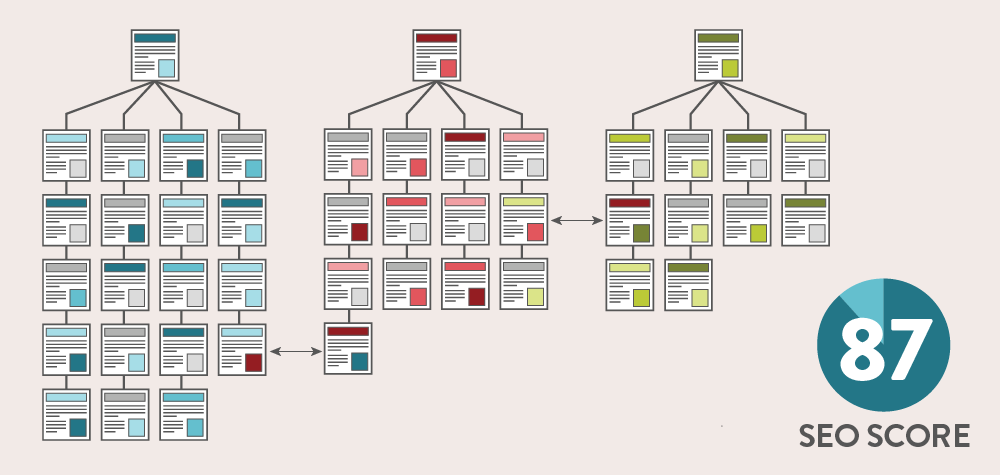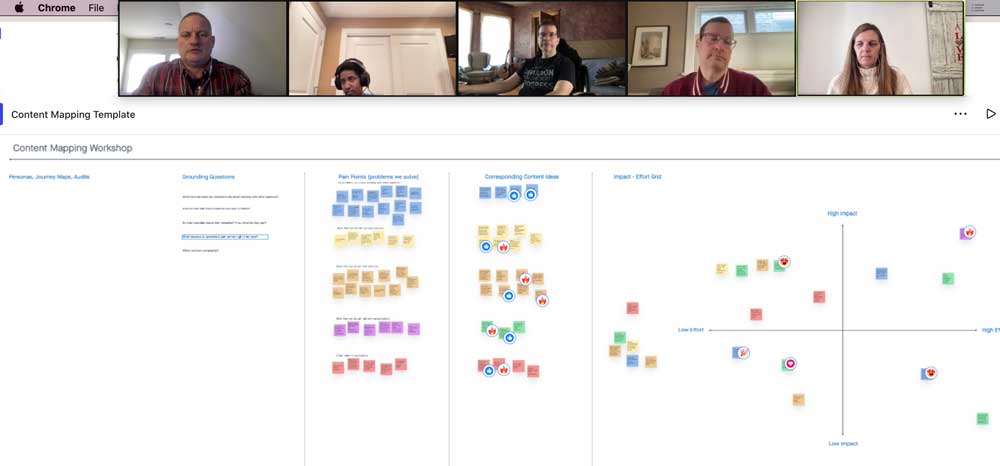Content Clusters: The Pillars of Your Content Strategy

Content clusters are important to both SEO and content strategy. But how, specifically, do they work? In this post, we explore how content clusters can improve your digital marketing while also helping users quickly find content that is relevant to their needs.
Over the past few months, Mightybytes facilitated several content strategy workshops where we employed content mapping and topic clustering exercises to help clients get a better handle on their content strategy. During these workshops, we found attendees had many questions about content clusters in general, how to create them, why they’re important, and so on.
Let’s demystify content clusters and explore how they can improve your digital marketing.
What are Content Clusters?
A content cluster is a group of content (posts/pages/etc) clustered around a single uniting topic that your website users or target customers are interested in.
Content clusters have a specific structure, which includes a cornerstone post—the most comprehensive piece of content on a topic on your website—and supporting posts, each of which covers a subtopic in greater detail. Links between the various posts in a cluster help users (and search engines) find related topics.

What Role do Content Clusters Play in Your SEO Strategy?
Content clusters are useful to SEO in a few key ways:
- They provide more structure to your content strategy by fully exploring a given topic rather than producing one-off content.
- Internal linking helps both people and search engines identify and find related topics of interest.
- Regularly producing well-researched content on a topic can improve your standing with search engines as an authority on that subject.
For example, Mightybytes’ blog includes many content clusters, including one on the topic of sustainable web design. This cluster explores best practices for creating high-performing, low-carbon websites. Since the early 2010s, we have written extensively on various aspects of this topic and aggregated those in a cornerstone post that provides a detailed overview.
Our search rankings for sustainable web design continue to perform well because of this strong foundation and an ongoing commitment to exploring the subject. Also, as time and resources permit, we update content to improve individual posts and add new ones, which helps us maintain results.
However, even the best written piece of content on the internet has limited ability to rank well if search engines are unable to recognize it as an important piece of content from a qualified, authoritative source. So, how do you indicate that your organization is an authority on a topic?
Google and other search engines use many indicators to determine what to include in their search results. Yet two things remain true:
- Consistently creating high-quality, well-researched content on a specific topic can positively influence your rankings.
- Well-structured content has a better chance of ranking well than poorly organized content.
Utilizing a content cluster strategy can help you improve your efforts in both these areas.

Elements of a Successful Content Cluster
Next, let’s look at the components any content cluster needs for success. Content clusters consist of several basic elements:
- Keywords: a list of well-researched keywords that the cluster is meant to target
- Cornerstone Post: a detailed post that gives a comprehensive overview of a typically broad topic
- Subtopics: supporting content on individual components of the overall topic
- Links: keyword-rich hyperlinks that connect supporting content to the cornerstone post
- Long-term Commitment: measurable strategies to improve cluster performance over time
Here’s how each of these individual elements influence your clusters.
1. Topic Modeling and Keyword Research
Structuring content clusters around users’ needs is crucial. Knowing which topic to cover is just the beginning.
For example, let’s say your environmental charity is trying to raise awareness about plastic pollution. In addition to driving qualified traffic from people who care about this issue, you want to increase signatures on a plastic pollution action pledge as well.
A content mapping process can help with this. We recommend you run through this full process (see link) when fleshing out content clusters. However, here’s a simplified version with a few key questions to ask:
- What problem is your target audience trying to solve? What do they want to learn about?
- Which solutions to address the issue of plastic pollution can your environmental charity offer better than anyone else?
- Is the solution you offer likely to get a conversion, i.e. will they sign your action pledge?
After going through this process, you might identify plastic pollution as first target content cluster. The cluster structure might look something like this:
- Topic – Plastic pollution
- Subtopics:
- How to reduce plastic waste
- Microplastics in drinking water
- Microbeads vs. microplastics
- Demystifying plastic recycling
- And so on…
The last post in the list above might be part of a cluster on recycling as well. It is okay for targeted subtopic posts to be included in two different clusters.
Next, if a prospective reader lands on one of your cluster pages, what action do you want them to take? Also, what potential barriers might exist for someone thinking about taking the pledge? How will you diminish, demystify, or remove those barriers?
Center each piece of content around a single, definitive purpose. Page briefs can help with this.
Every subtopic post written in the cluster links back to your cornerstone post, typically using hyperlink anchor text variations of the keyword or phrase you want to rank for. This indicates that your cornerstone post on plastic pollution is the most important and complete piece of content on the topic. It also offers readers a place to find more related information.
Searcher Intent
Understanding searcher intent is also vital to get the most out of your content cluster strategy.
Keeping with the plastic pollution example, produce content that meets user needs. Review the search volume of specific questions users might have:
- What’s the best way to address the problem of plastic pollution?
- How might I start recycling plastics at home?
- Can I effectively communicate the importance of plastic pollution at work?
- What are common barriers that may impede someone from taking action on plastic pollution?
As an example, there is a difference between a user looking for recyclable plastic and someone searching for what types of plastic can you recycle?. One might be looking for recyclable plastic products, packaging, or information about recycling labels. The other wants to know if a specific item can be recycled. That person might be more likely to take action via your form in that moment than someone passively looking for information.
This is why user intent is so important to focus on during keyword research. Some keyword tools indicate user intent. However, anybody conducting keyword research should always ask themselves why someone might use that keyphrase in a search.
You want to make sure the answer aligns with whatever content goals you have. If not, maybe you should reconsider those posts. Content clusters are labor-intensive so achieving some sort of measurable return on your efforts is important.

2. Pillar or Cornerstone Posts
The cornerstone post is the heart of your content cluster. Cornerstone posts seek to provide a complete overview for the topic that your content cluster addresses. These posts cover a lot by design. As such, they are usually pretty long with lots of links and references.
A cornerstone post should touch on all of the subtopics in your content cluster on a high-level. It also traditionally covers a keyword with high search volume that is a bit more difficult to rank for than your subtopic keywords.
In the previous example, the cornerstone post might use the keyword plastics pollution while the action on that page might be to encourage a user to sign the pledge.
3. Subtopics: Supporting Posts
Subtopics focus on long-tail keywords (very specific terms) and tend to provide in-depth analysis of one element of the main topic. Because of their inherent specificity, these terms tend to be easier to rank for. They also often focus on users with more specific intent: those who might be ready to make a purchase or otherwise convert.
The subtopics’ secondary role is to link to the cornerstone post to indicate to crawlers that the cornerstone is the most important page in the cluster. For linking, this indicates authority.
4. Internal Linking
Search engines use web crawlers to determine what is on the internet, how it is organized, and influence how websites are ranked. Crawlers do this by finding web pages, analyzing them, following links on the page, and repeating that process over time. Because of this, a logical and well integrated internal linking strategy will help search engines (and users) understand website structure and how content is organized.
In other words, pages you want search engines to index should be linked to one another. Every website features a link hierarchy that includes primary navigation, secondary navigation, and so on. For blogs, categories and tags help with this as well.
Content clusters are structured with the cornerstone post positioned at the top of a content pyramid. Subtopics, in turn, support the overall structure by linking back to the cornerstone content. This establishes your cornerstone post as being the most important piece of content on that topic on your website.
5. Using a Content Calendar for Ongoing Improvements
Finally, content clusters, at their heart, rely on either updating content to become components of the cluster or producing new content entirely. Either way, utilizing a content calendar can provide structure and keep your organization accountable to set deadlines.
A content calendar can also help you:
- Keep track of content production steps, deadlines, and so on
- Know when when to audit existing content to assess gaps
- Manage schedules and resources to improve clusters over time
- When dovetailed with a clear measurement strategy, better understand how content is performing against your business goals
This can help you make sure that outdated content in your cluster is brought up to date when it becomes necessary. However, a content calendar is only useful when used effectively and built into everyone’s schedule.
A Content Cluster Exercise
There are many ways to approach creating a content cluster but we wanted to outline the process we recommend for approaching a new content cluster. You can follow these steps to run a content cluster exercise with your team:
- Run a content audit.
- Host a content mapping workshop:
- For existing content: identify quick fixes on moderately performing posts
- For new content: do keyword research & identify search intent for topics you have expertise in
- Map topics & subtopics from your workshop to keyword research
- Craft the cornerstone post first
- Add subtopic posts with links as time/resources allow
- Measure performance over time: are you improving upon your goals?
Content Clusters: Last Word
Content clusters can be a valuable component of your organization’s overall content and marketing strategies. By following the above steps, you can get on the road to creating content in a more intentional way. You’ll also reap the benefits of structuring content to bring greater value to your audience.



